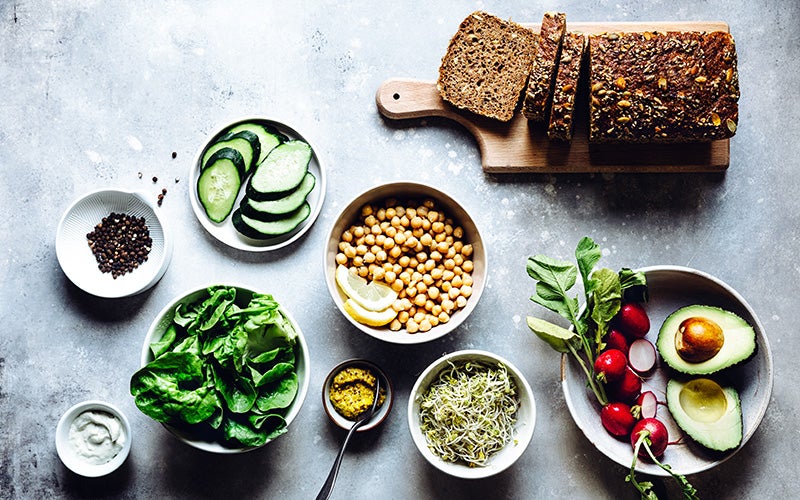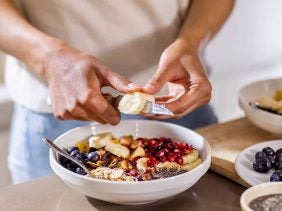Healthy foods and recipes for a fitter lifestyle
 ©alvarez
©alvarez
If you want to start eating healthier, it can be difficult to know where to start. Conflicting nutrition information and diets can make it hard to know which ingredients are actually healthy food. This article will help you cancel out the noise and hone in on the healthy foods that are right for your particular body. We’ll show you what food categories are most important to your general well-being, and the pantry staples that will always make sure your needs are met.
The Rules of Healthy Eating
Though healthy eating may seem like a simple idea, it’s far from it. In general, a healthy diet will consist of a balanced amount of the macronutrients fat, carbohydrates, and protein per meal. All the myths spread by the diet industry are where things get complicated. Though fat was long villainized by the diet industry, newer research shows that going completely fat free can be more harmful than we originally realized.
Nowadays, there’s also an emphasis on avoiding processed foods, but that doesn’t mean you always need to. Many foods undergo a process before ending up in your kitchen, whether that’s cheese that’s been fermented or a can of pre-cooked beans. Not everything is as highly processed as candy. But when in doubt, always check the nutrition label to know what you’re getting.
With a mix of shelf-stable staples and plenty of other nutritious foods, you can eat healthy in a way that tastes good, too!
Here is an overview of the most important rules of healthy eating:
- Calculate your basal metabolic rate: It can be helpful to know how much energy you consume on a daily basis so that you can provide your body with the right amount of calories through what you eat. Eating around 300 to 500 fewer calories from what you normally eat is necessary for weight loss. But you’ll need to eat more if you want to gain muscle.
- Diversify your diet: One food won’t make you unhealthy right away. Everything from pizza to ice cream is fair game on a healthy eating plan, so long as you’re eating in a balanced way—no need to go fully carb or fat free! For example, white bread can totally be part of a nutritious meal when combined with veggies, protein, and a fat source like avocado.
- Eat in a balanced way: Eating a balanced diet refers to giving your body the nutrients it needs to function at its best. The three main food groups that you need are carbohydrates (about 45% of your diet), fat (about 30%), and carbohydrates (about 25%). You also need micronutrients like minerals and vitamins to maintain a healthy lifestyle, but you’ll usually get these through what you’re already eating.
- Don’t demand too much of yourself: Say goodbye to strict diets and deprivation and hello to healthy eating that feels good. Once you become familiar with the foods that make you feel best, you’ll be able to build meal plans that suit your needs based on intuition alone.
- Make sure you always have the basics in your pantry: Having a well-stocked pantry makes it much easier to stay on top of what you eat. If you always have the basics on hand and a few healthy recipes in mind, then you’ll always be just minutes away from a meal. Here are the most important foods to have in your cupboard and some great recipe ideas!
Want to know more? Click here to find out all about healthy eating.
No. 1: Fruits and Vegetables
Fruits and vegetables are particularly nutritious foods because they contain many essential nutrients, like minerals, trace elements, and vitamins. Reach for fiber and calcium rich foods to ensure bone health and good digestion while you’re at it.
The Department of Health recommends eating at least two servings of fruit and three servings of vegetables a day. That’s about 400 grams of fresh vegetables and about 250 grams of fresh fruit per day.
Healthy Fruits and Vegetables to Keep In Your Pantry
- Lettuce
- Spinach
- Broccoli
- Cucumber
- Tomato
- Mushrooms
- Zucchini
- Scallions
- Bananas
- Apple
- Berries
- Dried fruits
Fruit and Vegetable Recipe Ideas
- Fruity Cherry Waffle and Protein Parfait
- Green Smoothie
- Zucchini Noodle Salad With Peanut-Coriander Pesto
No. 2: Grains, Seeds, and Starches
Starch- and grain-based ingredients like potatoes and bread are huge sources of energy. Carbohydrates are one of the central elements of any healthy diet because they’re the bodies’ main source of energy. Many carby ingredients are also nutrient dense foods, containing myriad vitamins and minerals, like vitamin B, iron zinc, and magnesium, as well as plenty of fiber and plant protein.
Our tip: Potatoes get a bad rap, but the humble starch is an incredibly nutritious food. Click here to find out why potatoes are so healthy and how they can help you lose weight!
Vegetarians and vegans have to rely heavily on grains, seeds, and starches in order to meet their protein needs without meat. Many grains contain around 20% protein.
Healthy Whole Grains, Seeds, and Starches to Keep in Your Pantry
- White rice
- Brown rice
- Quinoa
- Oatmeal
- Millet
- Buckwheat
- Flaxseed
- Chia seeds
- Sweet potatoes
Whole Grain, Seed, and Starch Recipes
No. 3: Legumes
Legumes like beans and lentils are beloved by vegetarians and vegans for their naturally high protein and carbohydrate content. They’re also rich in fiber, vitamin B, and minerals like iron, magnesium, and potassium.
Healthy Legumes to Keep in Your Pantry
- Chickpeas
- Kidney beans
- Lentils
- Lima beans
- Black beans
- Pinto beans
- Peanuts
Legume Recipe Ideas
No. 4: Animal Proteins and Plant-Based Protein Sources
Eating enough protein is vital to our physical well-being. We need this nutrient to do everything from developing new muscles to maintaining hormonal balance. Animal products are extremely rich in protein, but it’s totally possible to get enough without vegan or vegetarian alternatives alone. Here are a few more examples of protein foods.
Healthy Protein Sources to Keep in Your Pantry
- Poultry
- Seafood
- Shellfish
- Cottage cheese
- Cheddar cheese
- Eggs
- Red meat
- Tofu
- Tempeh
- Oat milk
Animal and Plant Protein Recipe Ideas
No. 5: Healthy Fat Sources
Last but not least, healthy fats like poly and monounsaturated fats contribute greatly to overall health. Though saturated fats can be harmful, omega-3 fatty acids are easy to digest and they make fat-soluble vitamins like A, D, E, and K more bioavailable. And research has shown that they can lower cholesterol levels.
Healthy Fat Sources to Keep in Your Pantry
- Flaxseeds
- Chia seeds
- Nuts
- Fish
- Avocado
- Coconut
- Extra virgin olive oil
Recipe Ideas with Healthy Fat Sources
Healthy Foods: Our Conclusion
With all this new knowledge, healthy eating will never seem difficult again. If you’re ready to get started right away, our shopping list has just what you need to feel and eat well.
Pantry staple shopping list:
| Grains, seeds, and starches |
| Rice |
| Quinoa |
| Oats |
| Millet |
| Whole-grain flour |
| Flaxseeds |
| Chia seeds |
| Sweet potato |
| Legumes |
| Chickpeas |
| Red beans |
| Lentils |
| Black beans |
| Vegetables |
| Salad |
| Spinach |
| Broccoli |
| Cucumber |
| Tomatoes |
| Mushrooms |
| Zucchini |
| Scallions |
| Fruits |
| Bananas |
| Apples |
| Berries |
| Dried fruit |
| Animal products |
| Chicken |
| Turkey |
| Salmon |
| Shrimp |
| Cottage cheese |
| Cheddar cheese |
| Eggs |
| Vegetarian lternatives |
| Tofu |
| Tempeh |
| Oat milk |
| Sources of healthy fats |
| Flaxseeds |
| Chia seeds |
| Nuts |
| Fish |
| Avocado |
| Coconut |
Sources for this article
We at foodspring use only high-quality sources, including peer-reviewed studies, to support the facts within our articles. Read our editorial policy to learn more about how we fact-check and keep our content accurate, reliable, and trustworthy.

































